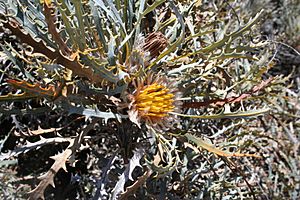Summer dryandra facts for kids
Quick facts for kids Summer dryandra |
|
|---|---|
 |
|
| At Charles Gardner Nature Reserve | |
| Scientific classification | |
| Genus: |
Banksia
|
| Species: |
vestita
|
 |
|
| Distribution of B. vestita, shown on a map of Western Australia's biogeographic regions. | |
| Synonyms | |
|
|
The Banksia vestita, also known as summer dryandra, is a type of shrub found only in the southwest part of Western Australia. It has long, narrow leaves with pointy teeth along the edges. This plant produces yellow flowers that grow in groups of about thirty to forty. After flowering, it forms egg-shaped seed pods.
Contents
What Does the Summer Dryandra Look Like?
The summer dryandra is a shrub that usually grows up to about 1.5 meters (5 feet) tall. It has stems that feel a bit hairy. Its leaves are long and narrow, typically 8 to 15 centimeters (3-6 inches) long and 0.7 to 1.3 centimeters (0.3-0.5 inches) wide. Each leaf has between four and twelve sharp, triangle-shaped teeth on both sides.
The flowers are a bright golden yellow and grow in a dome shape, about 3.5 centimeters (1.4 inches) across. Each flower head usually has thirty to forty individual flowers. The plant flowers from January to April, or sometimes in August. After the flowers, it produces broad, egg-shaped seed pods that are about 1 to 1.4 centimeters (0.4-0.6 inches) long.
How Did the Summer Dryandra Get Its Name?
The summer dryandra was first collected by a botanist named James Drummond in the 1840s. It was officially named Dryandra vestita in 1855 by Richard Kippist and Carl Meissner. The name "vestita" comes from a Latin word meaning "clothed." This refers to the hairy parts that cover the new shoots of the plant.
Later, in 2007, scientists decided to move all Dryandra plants into the Banksia group. This is why its scientific name is now Banksia vestita.
Where Does the Summer Dryandra Grow?
The summer dryandra grows in sandy soil that often has a layer of laterite underneath. It likes to grow in heathland areas, which are open spaces with many small shrubs. You can find it from Eneabba in the north all the way down to Lake Grace in the south of Western Australia.
This plant lives in areas that get about 350 to 600 millimeters (14-24 inches) of rain each year. It also experiences many hot days, with temperatures often above 30°C (86°F).
Life Cycle and Adaptations
Like many other plants in the Proteaceae family, the summer dryandra has special roots called proteoid roots. These roots grow in dense clusters just below the surface of the soil. They help the plant take in nutrients from poor soils, especially in places where there isn't much phosphorus.
The summer dryandra also has a special woody swelling at its base called a lignotuber. This helps the plant survive bushfires. If a fire burns the plant above ground, the lignotuber allows it to sprout new growth from underground. Bushfires also help the plant's seeds to be released from their pods, which is a process called serotiny.
Scientists have studied how climate change might affect this plant. They predict that the area where the summer dryandra can grow might shrink by 30% to 80% by the year 2080, depending on how much the climate changes.
Is the Summer Dryandra Protected?
The Western Australian Government's Department of Parks and Wildlife currently lists the summer dryandra as "not threatened." This means it is not considered to be in danger of disappearing.
Growing Summer Dryandra in Gardens
The summer dryandra is not often grown in home gardens because it's not considered a very showy plant. However, it is a long-lived plant. Some plants at the Royal Botanic Gardens, Cranbourne are still healthy and flowering even after twenty years!
Its seeds take about six to seven weeks to sprout, and about 70% of them successfully grow. If you want to grow it, it needs very sandy soil that drains well and lots of sunshine. It can handle dry conditions and is also quite good at surviving moderate frosts. It can also be pruned well.

